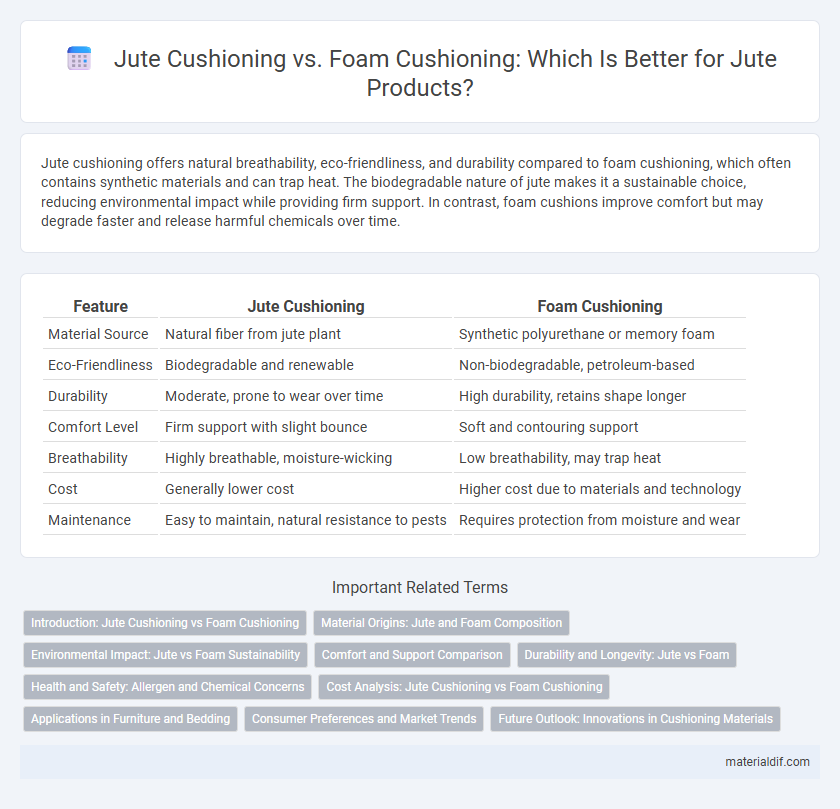Jute cushioning offers natural breathability, eco-friendliness, and durability compared to foam cushioning, which often contains synthetic materials and can trap heat. The biodegradable nature of jute makes it a sustainable choice, reducing environmental impact while providing firm support. In contrast, foam cushions improve comfort but may degrade faster and release harmful chemicals over time.
Table of Comparison
| Feature | Jute Cushioning | Foam Cushioning |
|---|---|---|
| Material Source | Natural fiber from jute plant | Synthetic polyurethane or memory foam |
| Eco-Friendliness | Biodegradable and renewable | Non-biodegradable, petroleum-based |
| Durability | Moderate, prone to wear over time | High durability, retains shape longer |
| Comfort Level | Firm support with slight bounce | Soft and contouring support |
| Breathability | Highly breathable, moisture-wicking | Low breathability, may trap heat |
| Cost | Generally lower cost | Higher cost due to materials and technology |
| Maintenance | Easy to maintain, natural resistance to pests | Requires protection from moisture and wear |
Introduction: Jute Cushioning vs Foam Cushioning
Jute cushioning offers a natural, biodegradable alternative to traditional foam cushioning, providing breathability and eco-friendly properties ideal for sustainable furniture solutions. Foam cushioning, made from synthetic materials, delivers superior softness and support but lacks the environmental benefits of jute. Choosing between jute and foam cushioning depends on priorities such as comfort, durability, and environmental impact.
Material Origins: Jute and Foam Composition
Jute cushioning is derived from the natural fibers of the jute plant, providing an eco-friendly and biodegradable alternative known for breathability and durability. Foam cushioning, typically composed of polyurethane or memory foam, is a synthetic material engineered for superior support and contouring comfort but lacks natural biodegradability. The contrasting origins of jute's plant-based composition and foam's petrochemical synthesis influence their environmental impact and performance characteristics in cushioning applications.
Environmental Impact: Jute vs Foam Sustainability
Jute cushioning offers a biodegradable and renewable alternative to foam, significantly reducing environmental pollution and landfill waste. Foam cushioning, derived from petroleum-based products, contributes to higher carbon emissions and persistence in ecosystems due to its non-biodegradable nature. The sustainability of jute is enhanced by its low water and pesticide requirements compared to synthetic foam materials.
Comfort and Support Comparison
Jute cushioning offers natural breathability and firmness, promoting better air circulation and eco-friendly comfort compared to foam cushioning. Foam cushioning provides consistent support by conforming to body contours, enhancing pressure relief but may trap heat and reduce ventilation. The choice between jute and foam cushioning depends on the balance desired between natural airflow and adaptive ergonomic support.
Durability and Longevity: Jute vs Foam
Jute cushioning offers superior durability and longevity compared to foam cushioning due to its natural fiber composition, which resists compression and retains its shape over time. Foam cushioning, while initially softer and more flexible, tends to degrade faster, losing resilience and developing permanent indentations with prolonged use. The biodegradable and breathable properties of jute also contribute to its long-lasting structural integrity, making it a sustainable choice for durable cushioning.
Health and Safety: Allergen and Chemical Concerns
Jute cushioning offers a natural, hypoallergenic alternative to foam cushioning, which commonly contains synthetic chemicals and volatile organic compounds (VOCs) that may trigger allergies or respiratory issues. Unlike foam, jute is free from harmful flame retardants, formaldehyde, and phthalates, making it safer for sensitive individuals and indoor air quality. The biodegradable and chemical-free nature of jute cushioning reduces long-term health risks associated with foam off-gassing and chemical exposure.
Cost Analysis: Jute Cushioning vs Foam Cushioning
Jute cushioning offers a cost-effective alternative to foam cushioning, with raw material prices significantly lower due to jute's natural abundance and biodegradability. Foam cushioning costs escalate because of petroleum-based production, chemical additives, and energy-intensive manufacturing processes, resulting in higher retail prices. When factoring in durability and environmental disposal costs, jute cushioning presents a more economically sustainable option for eco-conscious consumers and manufacturers.
Applications in Furniture and Bedding
Jute cushioning offers superior breathability and eco-friendliness, making it ideal for sustainable furniture and bedding applications where natural materials are preferred. Foam cushioning provides enhanced support and durability, suited for modern furniture designs requiring consistent comfort and resilience. Furniture manufacturers often choose jute for organic aesthetics and moisture-wicking properties, while foam is favored in high-density seating and mattress cores demanding long-lasting performance.
Consumer Preferences and Market Trends
Jute cushioning offers eco-friendly, biodegradable properties that increasingly appeal to environmentally conscious consumers, driving a shift in market demand towards sustainable materials. Foam cushioning remains popular for its superior comfort, durability, and cost-effectiveness, maintaining strong market share, especially in mainstream furniture sectors. Emerging trends indicate a growing niche market for hybrid products combining jute's natural benefits with foam's cushioning performance, reflecting evolving consumer preferences prioritizing both sustainability and comfort.
Future Outlook: Innovations in Cushioning Materials
Jute cushioning presents an eco-friendly alternative to foam cushioning, with innovations focusing on enhancing its durability, moisture resistance, and comfort through natural fiber treatments and hybrid composites. Advances in biodegradable coatings and bio-based adhesives are expected to improve jute's resilience, making it a strong contender in sustainable cushioning for furniture and automotive industries. Market trends driven by environmental regulations and consumer demand for green materials anticipate increased adoption of jute-based cushioning in the next decade.
Jute Cushioning vs Foam Cushioning Infographic

 materialdif.com
materialdif.com